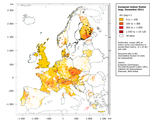neazoi
Advanced Member level 6
Radon safety in basement
Hi, my friend near me, has a basement and we are located in a part of our country that is NOT KNOWN if it has high soil radon concentrations. However our area is not listed in the high concentrations areas.
His basement floor is about 3 meters from top ground and has reinforced concrete walls (20cm thick) and reinforced concrete floor (about 60cm thick), both having iron bars armatures inside the concrete. The floor and the walls are joined together so the whole construction is more like a solid single piece of concrete all around the basement perimeter and floor, with no cracks in the joints to allow something to pass from the soil nearby inside the basement.
He needs to know if he is in danger because or radon, based on the above mentioned things.
I have a small cheap ($40) russian wearable dosimeter that can detect radioactivity from these old watches and I did some measurements in his basement and did not find any traces of radioactivity (at least with this meter). Wouldn't I be able to detect something even with this simple dosimeter if radon was there?
Hi, my friend near me, has a basement and we are located in a part of our country that is NOT KNOWN if it has high soil radon concentrations. However our area is not listed in the high concentrations areas.
His basement floor is about 3 meters from top ground and has reinforced concrete walls (20cm thick) and reinforced concrete floor (about 60cm thick), both having iron bars armatures inside the concrete. The floor and the walls are joined together so the whole construction is more like a solid single piece of concrete all around the basement perimeter and floor, with no cracks in the joints to allow something to pass from the soil nearby inside the basement.
He needs to know if he is in danger because or radon, based on the above mentioned things.
I have a small cheap ($40) russian wearable dosimeter that can detect radioactivity from these old watches and I did some measurements in his basement and did not find any traces of radioactivity (at least with this meter). Wouldn't I be able to detect something even with this simple dosimeter if radon was there?
